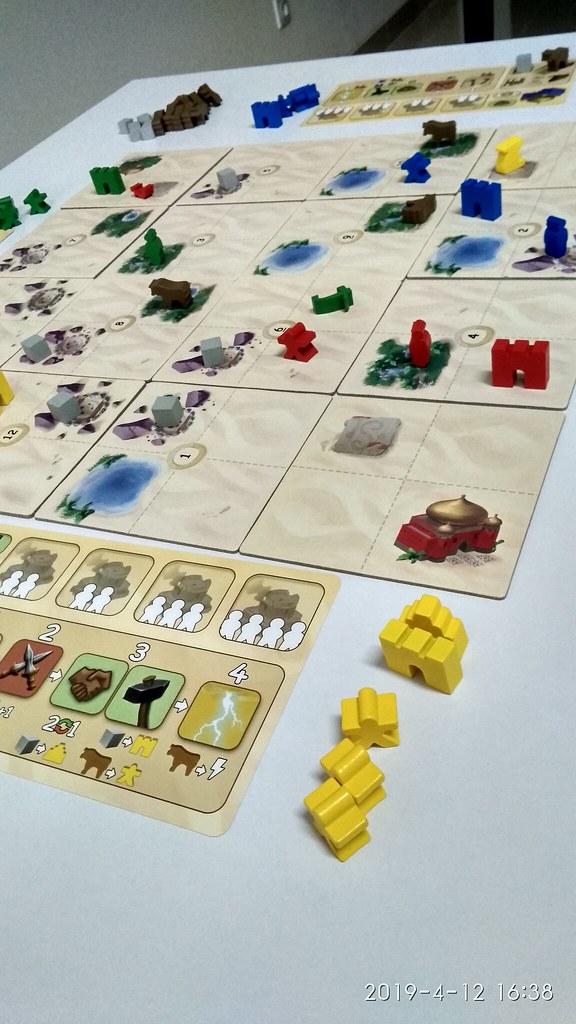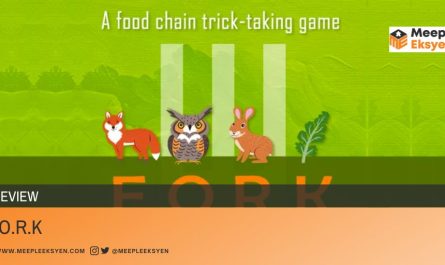Imagine this: you were brought to the desert ruined by the long war of the four tribes. The war had not yet ceased and now you were one of the tribe leaders guiding your armies through the vast desolate land to retain your tribe’s ancient relic while defending yourself from the invasion of other tribes. The glory you could achieve from pillaging the enemies would be written for generations. This experience you can get in Zoar.
Zoar is designed by Andreas Katelanos and published by Vesuvius Media. Our news during Spiel Essen 2018 covered them here. Below is my picture with Andreas. While you can read the tl;dr version of what Zoar is about, in this entry I will provide the review of what I have experienced from this euro board game.
Setting up Zoar for your group
First, separate the four capital tiles and shuffle the rest. Then, set up the tiles randomly from the shuffled tiles forming 4×4 gaming area; leave each corner to place the capital tiles. The capital area should be on the outer side of the gaming area.
After the tiles, now place the ancient relics of each tribe colour diagonally opposite the tribe’s capital city. Then, place one resource cube on the corresponding resource area on the tiles. You have metal and food resources in this game. Keep the other cubes nearby the gaming area.
Take one player board corresponding to the tribe you would play with; each tribe has its own unique skill. The player board is really useful because it acts as a guide for you during the game. Take the corresponding tokens in your colour; put your leader on the capital area and your armies and cities beside your player board. Please note that the yellow tribe gets additional 2 temple tokens. Distribute 1 metal and 1 food cube to each player. Now you can play the game.
An overview of the rules
A disclaimer: this overview will not cover all the rules and its purpose is solely giving you a glimpse of how Zoar goes. Meanwhile, some other parts may also be mentioned and commented in another chapter in this entry.
A game is fun to play and way more fun when you win it. So, how to win in Zoar? There are two conditions you can enact to triumph: you either bring back the ancient relic to your capital city or you can destroy numbers of enemies’ cities based on the player count. Each tribe, as mentioned, has its own unique skill that will help you to ensure your conquest goes well. Abuse this unique skill as often as possible! The game ends whenever one of two possible conditions is achieved.
The four phases in Zoar
The game consists of 4 phases: movement, combat, trade and build, and divine intervention. In the movement phase, you can move your tribe leader and/or your armies; the movement cannot be diagonal. While the leader may move freely except through a lake, your armies have more limitations; they cannot get through areas occupied by other tribes. When moving, you can gather resources and also move the ancient relic. Each tribe can only have up to 3 resource cubes per type. Tribe leader can move up to 2 spaces and armies can move only 1; you can add 2 extra moves by paying 1 food resource cube.
The combat can be initiated to the other tribe in an adjacent area. In combat, each player may call reinforcement by secretly spending metal resources and revealing it together. After the combat is resolved, then the cubes spent should be put back to the bank. In this phase, you can destroy enemies’ cities, if you have adequate strength.
After the combat phase, it’s time to build things up. You can build your city and armies in this phase; if you are the yellow tribe, you can even build the temple. You can trade your resource cubes if you need to with a ratio of 2:1; it means you need 2 food cubes to exchange it with 1 metal cube, for example.
The interesting last phase: Divine Intervention
The divine intervention happens in the last phase where you will roll the die. Do you see the numbers printed on the tiles? Whenever the corresponding number is rolled, then the effect of the divine intervention would occur on that tile. These effects vary greatly; God may grant you resources if you have city or unit on that tile. You may also build 1 army for free if you have a city on that tile. If there is an army and/or city of another tribe, it will be destroyed.
In this phase, you can even spend 1 food cube as offering to re-roll the die! If your city and/or army is about to be demolished by the unknown force, you can spend 1 metal cube to protect each of your units, too.
My experience with Zoar
Zoar is officially a very traditional euro game with its meeples and resource cubes, despite having a die to deliver judgment from the in-game mighty entity. It has open information on the table; it has no element of randomness except the divine intervention which will be decided by the die roll, of course. The die, however, plays a very crucial role in this game. Not only the numbers rolled would determine which resources would be replenished, but it will also determine the fate of your (and their) troops and cities.
Zoar needs patience and perception; we have to think two steps ahead while to be alert on whatever the other tribes are doing. We need to foresee what the other players will do to find an opening. I am glad the die is not used to roll the reinforcement (just like Risk) but instead players need to spend metal resources to call aids; this also incorporates bluffing and mind-games into Zoar.
Back to the random aspect, the die. I appreciate that Andreas tried to add this element to the game, but I think the power of God in this game is too omnipotent, risking a huge swing while playing the game. Imagine that you have made perfect moves and in the end-game God decided to just mess with you, destroying every living being in your city. Well, it happened; and mind you, the metal cubes you would spend for protection may not be enough when the ‘Divine Punishment’ comes.
My very personal opinion
Let’s start with what’s great. I really like how the resource cubes you acquired through movement phase are not readily available for the same round you collect it. It adds more planning to the game system. The die mechanic to decide which tile will get the effect from God’s crazy, random actions feels similar to the classical board game ever, Catan. While in Catan your fate is sealed since the first time you place your settlement, it’s not the case in Zoar because your units are all mobile except the city, of course.
Zoar is pretty much a euro game; you have to plan your moves ahead while predicting how the other tribes move next. The pace is quite fast and yet it has a very great depth. The resource cubes are not unlimited so you should be really careful with it. The core mechanic of this game is area movement fused with resource management.
The player board gives all the information needed for the player to play the game. All the phases are covered on the board, making it easier for all to know how to play without peeking to the rulebook too often. I also like how the army meeple is designed to fit with the ancient relic token; you can just put the relic token on top of the army meeple. The components are neat.
Well, although Zoar is a good euro game, I actually think the God’s influence should be a bit restricted here. It’s a good thing to have randomness merged into a euro game, actually. However, the way it affects the flow of the game is a bit too intense. It really makes a swing when God decides to hit a tile. It sure prevents meta to appear in the game, but I’d rather have a not-too-powerful kind of God in the game
Final thoughts
On the bright side, Zoar is still a very satisfying game despite the flaw we have discussed above. The two conditions to achieve victory keep the game in balance; you cannot just go for the relic without paying attention to the other tribes’ army that may march to your city. Zoar will attract audience for sure, especially those who loves euro game. It may not be your top 10 mostly played board games in your group, but it is a good addition to your collection. Finally, I would say that Zoar is most enjoyable with 4 players; you would still feel the heat with 3 tribes, though!
(pictures: Geoffrey Benawar & Juan)
I am a full-time food technologist during weekdays. However, when the calendar hits weekends, I transform into an avid board gamer. I am a hardcore Legend of the Five Rings (L5R) LCG player from Fantasy Flight Games (FFG). Current hobby: buying board games. My shelf of shame’s list is getting longer, thanks to you, Kickstarter.









